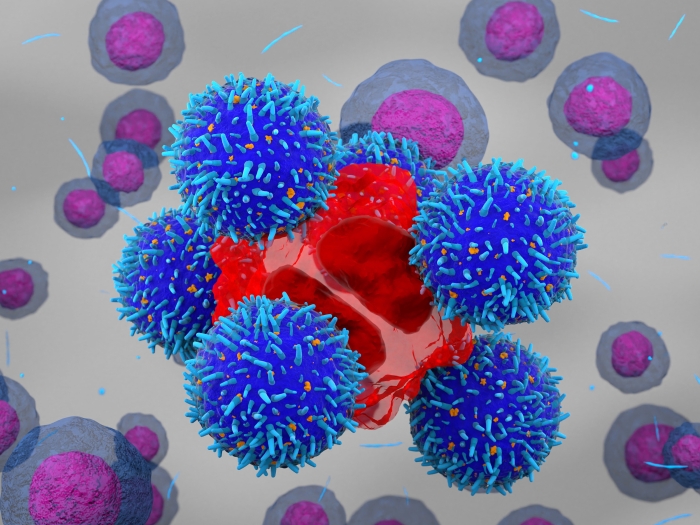Radiologists play a large role in many tumor diagnoses, but rarely get the recognition for it
5:00 AM
Author |

Qiong Liu., Ph.D., was experiencing some intense abdominal pain that was starting to concern her.
She decided to go to her family doctor at University of Michigan Health for an exam. Her physician ordered an ultrasound and an MRI to look at the uterus and ovaries and try to locate the source of the pain. The MRI revealed an enlarged appendix and the radiology team working on Liu’s case quickly recommended a CT scan to take a closer look.
Liu, a former history lecturer at the University of Michigan, had studied medical history in college and knew that the work of radiologists typically goes unnoticed. So when the radiology team at University of Michigan Health found the concerning mass in her appendix on a study that was not dedicated to evaluate the bowel, she felt it was important to share her gratitude with them, going so far as to send an email with shoutouts for specific radiologists.
“I’m incredibly grateful for the radiologists that caught this,” Liu said. “I think the radiologists deserve more recognition for their work. An early diagnosis from their team can save lives.”
Saving lives in the shadows
Radiologists are the “ones behind the curtain” when it comes to the discovery of cysts, tumors, and cancer diagnoses. Most radiologists go unacknowledged for their early detection of life-threatening abnormalities.
When trying to picture what a radiologist does, most people will first think of a radiographer. Radiographers are the folks that set up patients in the exam room and perform the requested imaging. Once the images are captured, they are sent to the radiologist.
A radiologist is a physician who specialize in interpreting images of a certain area of the body, like the abdomen or the breast. They review the images, search for any abnormalities or causes for concern, and then discuss the findings with the physician that ordered the scan.
"It is important that a radiologist works in a timely manner," said Hero Hussain M.D., a professor of diagnostic radiology at the University of Michigan Medical School. "Images need to be read quickly and correctly in order to administer the best care to the patient."
After reading the initial scan that was done to assess the female pelvic organs, Hussain recommended another scan to better examine the appendix and communicated her recommendation to the referring physician that Liu have her appendix removed to avoid any serious complications in the future.
“Imaging alone cannot tell if the enlarged appendix is cancerous or not,” said Hussain. "The safer option was for the appendix to be removed all together to avoid any risks."
Typically, radiologists also work with a tumor board. This meeting consists of specialists from areas of diagnosis and treatment who discuss each patient with or suspected of having cancer to determine what the patient could need to combat the cancer. The group is tailored to each patient’s specific needs to decide how to best proceed with treatment.
Upon receiving the results of the scan, Liu knew she needed to act quickly. While this type of tumor is rare, she had seen firsthand what happens when the condition goes untreated.
“My uncle had the same tumor and unfortunately, it developed into cancer because of misdiagnosis,” said Liu. “The tumor ruptured causing fatal fluid to flood his abdomen and he had to undergo intense chemotherapy.”
Liu had her appendix removed at the University of Maryland Medical Center after moving for a new job at the Virginia Military Academy. The procedure was straightforward, and her recovery time was quick; Liu was able to go back to teaching within the week.
Lab testing of the tumor showed that it was a low-grade appendiceal mucinous neoplasm, a lesion in the appendix that will result in mucus flooding the abdomen if left untreated. Without the early diagnosis from radiology, Liu would have been at risk of facing the same fate as her uncle.
Liu felt it was important to express her gratitude to the radiology team since she knows they don’t get much recognition for their work. She took the time to write out an email to the department thanking them for catching the tumor early.
"Great appreciation for your department, particularly Drs. Arvidson and Hussain! Thank you so much for the difference you make in my life!" Liu wrote. "Thank you so much for being so skilled at radiology. Every day of my life will be better because of you."
“As radiologists, you see many patients every day but rarely get to see the end result,” said Alexa Arvidson, a radiologist at the University of Michigan Health. “It’s heartwarming to see this follow up and know our work helped save Liu’s life.”

Explore a variety of health care news & stories by visiting the Health Lab home page for more articles.

Department of Communication at Michigan Medicine
Want top health & research news weekly? Sign up for Health Lab’s newsletters today!





